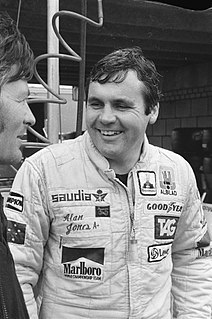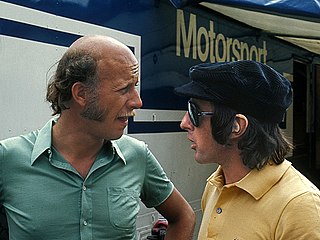Related Research Articles
McLaren Racing Limited is a British motor racing team based at the McLaren Technology Centre in Woking, Surrey, England. McLaren is best known as a Formula One constructor, the second oldest active team, and the second most successful Formula One team after Ferrari, having won 183 races, 12 Drivers' Championships and 8 Constructors' Championships. McLaren also has a history of competing in American open wheel racing, as both an entrant and a chassis constructor, and has won the Canadian-American Challenge Cup (Can-Am) sports car racing championship. The team is a subsidiary of the McLaren Group, which owns a majority of the team.

Alan Stanley Jones, is an Australian former Formula One driver. He was the first driver to win a Formula One World Championship with the Williams team, becoming the 1980 World Drivers' Champion and the second Australian to do so following triple World Champion Sir Jack Brabham. He competed in a total of 117 Grands Prix, winning 12 and achieving 24 podium finishes. In 1978 Jones won the Can-Am championship driving a Lola.
The Surtees Racing Organisation was a race team that spent nine seasons as a constructor in Formula One, Formula 2, and Formula 5000.

Formula Two, abbreviated to F2, also called Formula 2, is a type of open-wheel formula racing category first codified in 1948. It was replaced in 1985 by Formula 3000, but revived by the FIA from 2009–2012 in the form of the FIA Formula Two Championship. The name returned in 2017 when the former GP2 Series became known as the FIA Formula 2 Championship.
Lola Cars International Ltd. was a British race car engineering company in operation from 1958 to 2012. The company was founded by Eric Broadley in Bromley, England, before moving to new premises in Slough, Buckinghamshire and finally Huntingdon, Cambridgeshire, and endured for more than fifty years to become one of the oldest and largest manufacturers of racing cars in the world. Lola Cars started by building small front-engined sports cars, and branched out into Formula Junior cars before diversifying into a wider range of sporting vehicles. Lola was acquired by Martin Birrane in 1998 after the unsuccessful MasterCard Lola attempt at Formula One.

The 1973 Formula One season was the 27th season of FIA Formula One motor racing. It featured the 1973 World Championship of Drivers and the 1973 International Cup for F1 Manufacturers, which were contested concurrently over a fifteen-race series that commenced on 28 January and ended on 7 October. There were two new races for the 1973 season – the Brazilian Grand Prix at Interlagos in São Paulo and the Swedish Grand Prix at Anderstorp. The season also included two non-championship races which were open to both Formula One and Formula 5000 cars.
Robert Brett Lunger is an American racecar driver.
Connew Racing Team, commonly known as Connew, was a short lived British Formula One constructor. Founded in 1971 by Peter Connew, the team constructed a single car, the PC1. The first monococque had to be aborted due to a change in regulations and the second tub was known as PC2. However, record books show the car driven by Migault and others as PC1. The intent was to compete in the Formula One World Championship in 1972, but a lack of financial and technical resources meant that the car only managed to start in one championship race, the 1972 Austrian Grand Prix, with French driver François Migault at the wheel. Following the Austrian race, the car competed in a handful of non-championship races before being converted to meet Formula 5000 specifications for the 1973 season. The chassis was damaged beyond repair during the season finale at Brands Hatch and the team closed.
John Cannon was a sports car racer, who competed under the banner of Canada, though he was born in London, U.K. He raced in the USRRC series, the CanAm Series and the L&M Continental Series.

David Charles Purley, GM was a British racing driver born in Bognor Regis, West Sussex, who participated in 11 Formula One World Championship Grands Prix, debuting at Monaco in 1973.

Formula 5000 was an open wheel, single seater auto-racing formula that ran in different series in various regions around the world from 1968 to 1982. It was originally intended as a low-cost series aimed at open-wheel racing cars that no longer fit into any particular formula. The '5000' denomination comes from the maximum 5.0 litre engine capacity allowed in the cars, although many cars ran with smaller engines. Manufacturers included McLaren, Eagle, March, Lola, Lotus, Elfin, Matich and Chevron.

The McLaren MP4/6 is a successful Formula One racing car designed by McLaren's Neil Oatley, Matthew Jeffreys, David North, David Neilson, Bob Bell and Mike Gascoyne; powered by the Honda RA121E V12 engine for use in the 1991 Formula One season. It was driven by reigning World Champion, Brazilian Ayrton Senna, and Austria's Gerhard Berger.

The Lola T332 was a race car designed and built by Lola Cars for use in Formula 5000 racing and made its racing debut in 1973. The T332 was successful around the globe with race victories in places such as Australia, the United Kingdom, New Zealand and the United States. The Lola commonly used the 5.0-litre Chevrolet V8 engine, though some competitors in Australia and New Zealand used the slightly cheaper and less powerful Australian made 5.0-litre Repco Holden V8.

The Cooper T86 was a Formula One racing car built by Cooper and first raced in 1967. B and C specification cars were also built to accommodate different engines, but the car could not revive Cooper's fortunes and this type represents the last Formula One chassis built and raced by the former champion team.
The 1976 Shellsport International Series was a Formula Libre motor racing championship held in the United Kingdom, the series ran F1, F2, F5000 and Formula Atlantic cars in the same race. The first Shellsport International Series was contested over 13 rounds. The season started on 21 March and ended on 7 November. The Drivers' Championship was won by Englishman David Purley.
Ian Grob is a former English racing driver. He raced in a number of events, including European Formula 2 and Le Mans 24 Hours. He retired from international motor sport after his last race, 1980 24 Hours of Daytona.

The Chevron B28 was an open-wheel race car, designed, developed and built by British Manufacturer Chevron, for Formula 5000 racing, in 1973. It was driven by Peter Gethin, Teddy Pilette, Vern Schuppan, and Chris Craft. Briton Peter Gethin won 4 races in the 1974 season with the B28, eventually finishing second place, as runner-up in the championship, with 186 points. Gethin's Belgian teammate, Teddy Pilette, would finish fourth place in the championship, with 108 points. Chevron only produced two finished models of the B28. It did compete at the non-championship Race of Champions Formula One race, being driven by Peter Gethin, and its best result there was a 10th-place finish. It was later converted into a closed-wheel prototype-style car, and used in the revived Can-Am series in North America. As with most other cars of the time, it was powered by the commonly used Chevrolet small-block engine.
The 1973 Rothmans 5000 European Championship was a motor racing series for Formula 5000 cars. The series was organized in the United Kingdom by the British Racing and Sports Car Club but also incorporated European rounds. It was the fifth in an annual sequence of European Formula 5000 Championships, and the first to be contested as the Rothmans 5000 European Championship. The 1973 championship was won by Teddy Pilette, driving a McLaren M18 and a Chevron B24.

The Brabham BT43 was the only Formula 5000 racing car built by Motor Racing Developments (MRD). Initiated by Ron Tauranac, designed by Geoff Ferris, and built by a team including Nick Goozee (monocoque) and Bob Paton (construction), it was one of the last cars produced by MRD before MRD was closed by the then new Brabham owner Bernie Ecclestone. Based on the Formula Two Brabham BT40 the BT43 featured a modified monocoque that incorporated the triangular cross section pioneered by the Brabham BT42 Formula One car which was designed by Gordon Murray. This distinctive pyramid shape not only kept the aerodynamic "stagnation point" low but also neatly allowed the incorporation of a "crushable structure" as required by the 1973 regulations which specified that all fuel tanks were to be protected by deformable structures. Engine and gearbox were the then de facto F5000 standard combination of a Chevrolet 302 cubic inch engine in an unstressed mounting and a Hewland DG300 gearbox. The fitment of these into what was a relatively small Formula Two sized car presented some design challenges. Front suspension components were BT40 while rear suspension components were a combination of Formula One and BT40.
Keith Holland is a British former racing driver from England who competed in various classes of racing in the 1960s and 1970s. He is known for winning the 1969 Madrid Grand Prix in a Formula 5000 car in a field which contained several Formula One entries. He was also a regular competitor in the British Formula 5000 Championship finishing third in the title standings on two occasions.
References
- ↑ Brown, Allen. "Chevron B30 history". OldRacingCars.com.
- ↑ "Chevron B30" . Retrieved 28 June 2022.
- ↑ "Chevron Heritage". www.chevron-heritage.co.uk.
- ↑ "Heritage". www.f5000registry.com.
- ↑ "1975 Chevron B30 Purley". December 5, 2021.